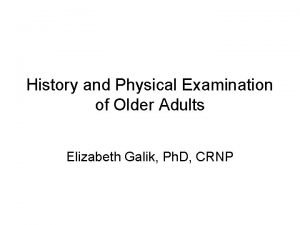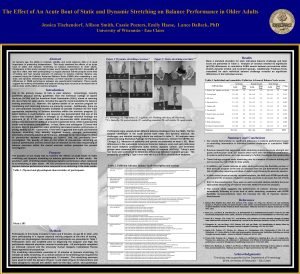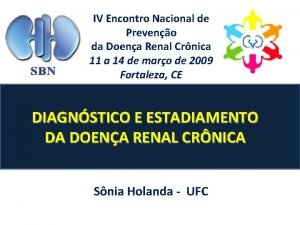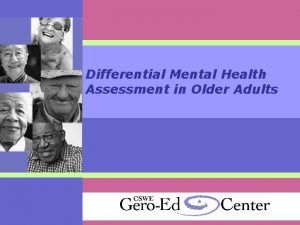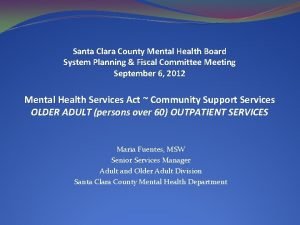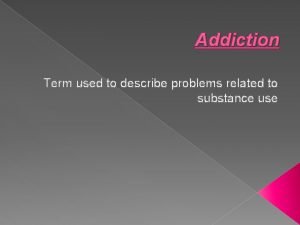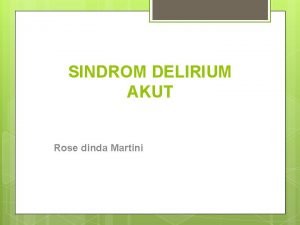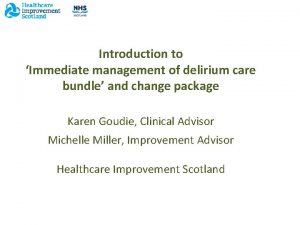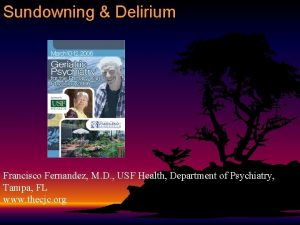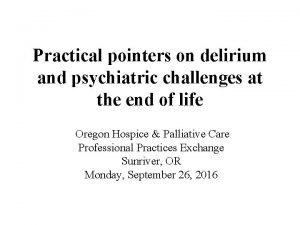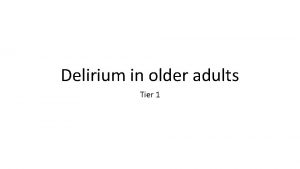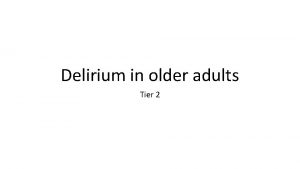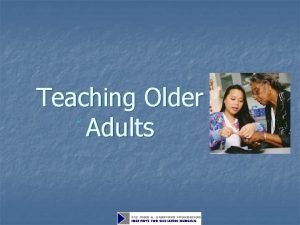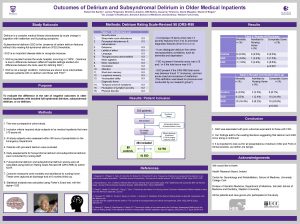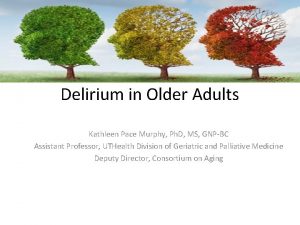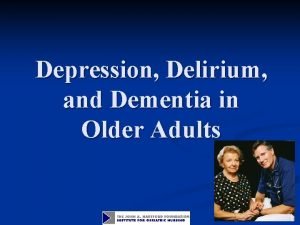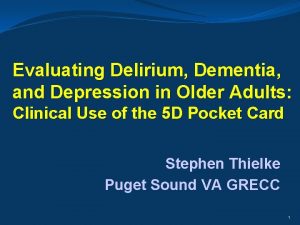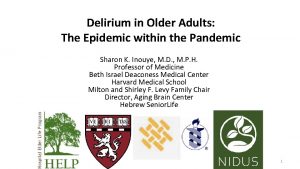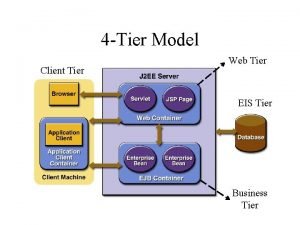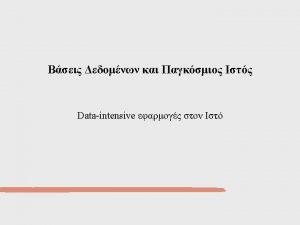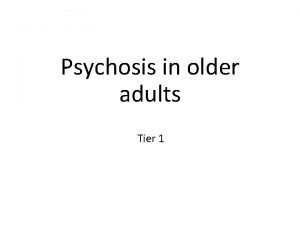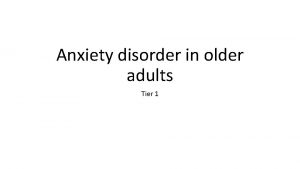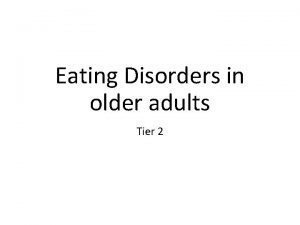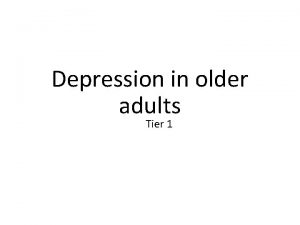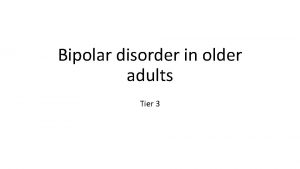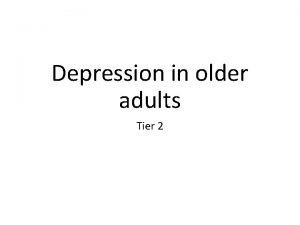Delirium in older adults Tier 3 Delirium is

















- Slides: 17

Delirium in older adults Tier 3

Delirium is an aetiologically nonspecific syndrome It can include disturbances of • Consciousness and attention • Perception • Thinking • Memory • Psychomotor behavior • Emotion • Sleep-wake cycle

Course of delirium • Usually transient and of fluctuating intensity • Most cases recover within 4 weeks or less • However, some may take up to 6 months • The delirious state may be superimposed on, or progress into, dementia. (ICD-10, 1992. ) • Delirium is associated with increased length of hospital stay, functional decline, increased morbidity and mortality and increased rates of institutionalization

Types • Hyperactive - most easily recognized type, this may include restlessness (for example, pacing), agitation, rapid mood changes or hallucinations, and refusal to cooperate with care. • Hypoactive - may include inactivity or reduced motor activity, sluggishness, abnormal drowsiness, or seeming to be in a daze. This is often missed • Mixed - both hyperactive and hypoactive signs and symptoms. The person may quickly switch back and forth from hyperactive to hypoactive states.

Causes are often complex and multifactorial • D Drugs including: opioids, anticholinergics, steroids, benzodiazepines, antidepressants, sedatives, dehydration, detox, deficiencies, discomfort (pain) -dementia • E Electrolytes (sodium, glucose, calcium ), elimination abnormalities, environment • L Lungs (hypoxia), liver, lack of sleep • I Infection, iatrogenic events, infarction (cardiac, cerebral) • R Restricted movement/mobility, renal failure/removal of alcohol • I Injury, impaired sensory input, intoxication • U UTI, unfamiliar environment • M Metabolic abnormalities (glucose, thyroid), metastasis (brain) • COVID causes delirium

Symptoms • • • Acute onset Fluctuating course Inattention Disrupted sleep pattern Reduced awareness Reduced alertness Altered consciousness & a change in cognition Hallucinations – usually visual Fleeting delusions Labile affect Orientation – variably impaired Memory – immediate & recent impairment

Predisposing Factors that have been identified as predisposing a patient to develop a delirium include: • Advanced age • Cognitive impairment • Severity of underlying illness • Depression • Dehydration • Sensory impairment • Functional impairment • Physical health conditions – stroke, neurological diseases, chronic renal or hepatic diseases

Precipitating Factors Events related to either hospitalisation or associated treatments can precipitate the development of delirium: • Surgical procedures – high incidence due to multiple insults to the body • Infection • Electrolyte imbalance • Disruption to sleep cycle • Change in medication regimes / multiple medications / medication errors • Pain • Unfamiliar environment • Poor nutrition / hydration • Constipation • Drug / alcohol withdrawal

Pathophysiology • Delirium = acute medical condition. • Pathophysiology is poorly understood. • Likely related to multiple physiological mechanisms that affect neurotransmission, inflammation and stress responses. • Disease and / or trauma leads to a physical stress response. • Stress response overwhelms the individual due to deranged neurotransmitter release and uptake.

Diagnosis • Clinical assessment is key • Consider using Confusion Assessment Method (CAM) as a screening tool or 4 AT • Get an accurate history from someone who knows the patient 10

3+ – possible delirium + cog impairment 1 -3 – possible cognitive impairment 0 – delirium unlikely


Management • • Address any infection and pain Ensure adequate hydration and nutrition Ensure glasses, hearing aids etc. are accessible Attention to the environment is essential. Quiet area or side room; limit staff changes Adequate lighting, minimise noise, provide a clock the patient can see Gentle repeated reorientation and to avoid confrontation Try to maintain normal sleep-wake cycle EXPLANATION is KEY • Explain cause and likely course to patient, relatives and carers • Address anxiety; patients with delirium are often frightened • Explain the organic cause of behaviour and symptoms 13

Management • Identify the underlying cause and treat appropriately • Manage the symptoms of delirium whilst the cause is found • Prevent injury and delirium complications—falls, wandering, harming self or others, skin breakdown, aspiration • Address predisposing & precipitating factors as appropriate


Management • Non-pharmacological measures to manage symptoms should be tried first which can include nursing in a single room, reorientation, using of appropriate lighting, offering reassurance • Assess for short term use of low dose antipsychotic medication if patient is disturbed by hallucinations or severe agitation and aggression. • Sedatives and hypnotics can prolong delirium therefore they should be used judiciously and in minimal doses • Combative and physically dangerous patients may require urgent reassessment

Delirium resources • HEE NE > PG Dean > Faculty of Patient Safety > Delirium Project This link has link to animated videos on delirium awareness and on being delirium ready. • Patient video (europeandeliriumassociation. org) This is the link to powerful video of what it is like to experience delirium. Leaflets for patients and relatives: https: //www. rcpsych. ac. uk/mentalhealth/problems-disorders/delirium
 Tier 1 2 3 vocabulary words
Tier 1 2 3 vocabulary words Tier 2 words examples
Tier 2 words examples Life is older than the trees
Life is older than the trees Shingles older adults
Shingles older adults Dynamic stretching for older adults
Dynamic stretching for older adults Mental health and older adults
Mental health and older adults Older adults
Older adults Mental health and older adults
Mental health and older adults Covids older adults
Covids older adults Altered cognition in older adults is commonly attributed to
Altered cognition in older adults is commonly attributed to Older adults mental health
Older adults mental health Flocculation delirium
Flocculation delirium Dr rose dinda martini
Dr rose dinda martini Escala de cam icu
Escala de cam icu European delirium association
European delirium association Energy transfer theory
Energy transfer theory Francisco fernandez md
Francisco fernandez md Nash delirium
Nash delirium



